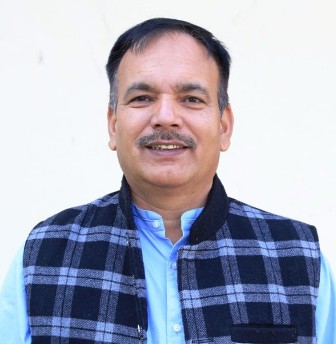Promoting Restoration Programmes on Degraded Lands through Medicinally Important Species – A Participatory Approach
Objectives -
1. To establish convergence with community institution for restoration through livelihood promotion and biodiversity conservation
2. To promote restoration through plantation of medicinally important species
3. To enhance capacity of the diverse group of stakeholders on restoration of degraded land
4. To develop value chain of the medicinally important produce and value addition in each site
5. To make cost-benefit analysis of each prototype developed
Approaches - The restoration initiative was implemented through a participatory, multi-stakeholder approach that integrated ecological rehabilitation with livelihood promotion. The project was carried out in nine villages across three pilot sites, namely Chandak–Aunlaghat, Haat–Kalika, and the Lower Gori watershed in Pithoragarh district, Uttarakhand. To ensure transparency and inclusiveness, 38 consultations and workshops were conducted, engaging 1,313 villagers, including 783 men and 530 women. Through dialogue with Gram Pradhans, Sarpanch, and villagers, degraded lands were identified for intervention. This collaborative decision-making was formalized by signing Memoranda of Understanding (MoUs) between community representatives and GBP-NIHE, leading to the allocation of 26 hectares of degraded land for restoration activities.
Implementation focused first on soil and moisture conservation work to enhance fertility and water availability. Low-cost measures such as bunding, gully plugging, staggered contour trenches and water harvesting ponds were adopted, while thawalas (semi-circular pits) were dug around saplings to retain soil moisture. Grasses such as Cymbopogon citratus were planted in gaps to prevent erosion, stabilize slopes and provide fodder. To protect restored sites, a range of fencing approaches was applied, including stone walls, barbed wire fencing combined with bio-fencing using thorny bushes, and social fencing through collective agreements. In frost-prone zones, saplings were further safeguarded with shade nets.
A diverse mix of ten medicinally important species along with five multipurpose trees (Cinnamomum tamala, Pittosporum eriocarpum, Myrica esculenta, Terminalia chebula, Terminalia bellirica, Phyllanthus emblica, Bauhinia variegate, Hedychium spicatum, Diploknema butyracea, Rubus ellipticus, Alnus nepalensis, Julgans regia, Quercus leucotrichophora, Q. glauca and Zanthoxylum armatum) were introduced through participatory plantation. The triangular planting method and Climate Resilient Agriculture techniques were employed to improve water-use efficiency and survival rates. Plantations were established on both Van Panchayat and private lands to ensure wider adoption, integration and long-term sustainability.
Capacity-building formed the backbone of the initiative. A total of 38 training programmes reached 937 participants, including 366 women, across 41 villages. Hands-on training covered nursery raising techniques, plantation methods, growth monitoring, invasive species management, and conservation practices. Villagers were empowered to maintain records of plant height, girth, and survival, and to carry out replacement of dead or diseased saplings, ensuring continuity in restoration efforts.The block-level synergy-building workshops played a pivotal role in strengthening collaboration among diverse stakeholders, including government departments, Van Panchayats, NGOs and community-based organizations. They provided a common platform for dialogue and cooperation. They enabled effective coordination on land allocation, resource mobilization and conflict resolution, while integrating government schemes into restoration activities. This multi-level engagement at the village, block and Van Panchayat levels not only maximized the benefits reaching local communities but also supported the development of exit strategies, ensuring that restoration initiatives could sustain themselves beyond project timelines.
The approach prioritized gender parity by addressing men’s and women’s needs, ensuring equal resource access, and engaging women in decision-making. Women were empowered through training, value-chain opportunities, and leadership roles in community organizations, enhancing participation and governance in restoration initiatives. Marginalized groups were included in decision-making and capacity-building programmes, ensuring equitable participation and benefit-sharing.
Outcomes -
1. Environmental Impact - A total of 26 ha of degraded land was restored across three watersheds, Haat Kalika (4.5 ha), Chandak Aunlaghat (5.5 ha) and Lower Gori Valley (16 ha) with an overall survival rate of 60.44% for the planted species. To enhance biodiversity, around 24,400 individuals belonging to 10 medicinally important tree and herb species were introduced, supporting ecological recovery and ensuring long-term ecosystem services. The restoration models also integrated soil and water conservation measures, including water/moisture retention and invasive species management, which significantly improved soil health and reduced land degradation risks. Additionally, convergence efforts under MGNREGA led to the fencing of 3 ha of land in Kamad village, minimizing grazing and human disturbances, thereby strengthening protection and sustainability of the restored sites.
2. Social Impact - A total of 937 villagers, including 571 men and 366 women from 41 villages, participated in 38 training programmes and workshops focused on nursery techniques, moisture conservation, invasive species management and growth monitoring, thereby enhancing local capacity and skill development. To ensure sustained knowledge dissemination, three training manuals were developed on (i) restoration of degraded land and monitoring, (ii) nursery management and plantation techniques and (iii) invasive species management. Community engagement was further strengthened through three synergy-building meetings involving 165 stakeholders (131 men and 34 women) in collaboration with eight line departments and community institutions, fostering participatory governance and local ownership. Additionally, 5,000 seedlings of Cinnamomum tamala were distributed among 120 villagers, encouraging livelihood diversification and the integration of medicinal plant cultivation at the household level.
3. Economic Impact - The plantation of high-value medicinal plants such as Cinnamomum tamala has created new opportunities for livelihood diversification by laying the foundation for community-based herbal product value chains. Convergence with schemes like MGNREGA and Bhesaj Sangh has further supported this process by providing seedlings and fencing assistance, thereby reducing community-level costs and improving access to resources. In addition, an ongoing economic valuation and cost–benefit analysis of Cinnamomum tamala aims to assess its financial potential, which is expected to highlight future income prospects and strengthen the development of sustainable medicinal plant-based value chains.

Plantation activity across various sites


